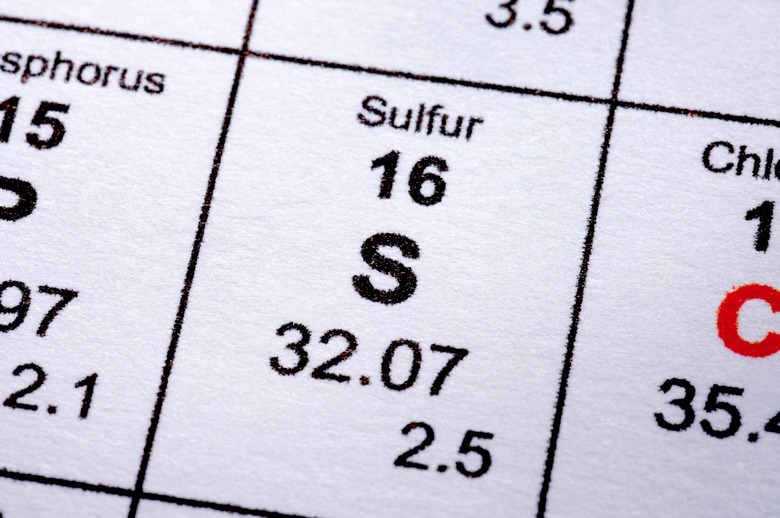How To Build A 3D Atom Structure Of Sulfur
A chemical element is generally defined as a substance that cannot be broken down into smaller parts, and which combines with other elements to form matter. As of the date of publication, there are an estimated 92 naturally occurring elements in the universe. Of these, sulfur is one of the most commonly studied. As with other elements, the function of sulfur is strongly related to its structure. Students who are interested in learning more about sulfur can gain a better understanding by building a 3D atomic structure of the element.
Step 1
Create the protons. Sulfur is composed of 16 positively charged protons, which are found in the nucleus of the atom. To create the protons, place a large sheet of newspaper on the floor of the workstation. Select 16 Styrofoam balls, put them on the newspaper and coat them with green spray paint. Shake the edges of the newspaper slightly from time to time, rotating the balls and exposing bare spots. Make sure all the Styrofoam balls have been completely painted before setting them aside to dry.
Step 2
Create the neutrons. The nucleus of the sulfur atom contains 16 neutrons, which do not provide a charge. Repeat the process described in Step 1 to paint the neutrons. Use red instead of green paint to provide differentiation, and set them aside to dry.
Step 3
Create the electrons. Sulfur contains 16 negatively charged electrons, which rotate outside the nucleus in an area known as the "electron cloud." Repeat the process described in Step 1 to paint the electrons black, and set them aside to dry.
Step 4
Form the nucleus. Use a hot glue gun to join the 16 green and 16 red Styrofoam balls. Glue the balls together in one large clump, attaching one at a time and allowing them to dry completely before adding any more. The protons and neutrons do not have to be connected in any certain order. In fact, the more randomized the nucleus appears, the more realistic it will be.
Step 5
Build the first energy level. The electron cloud is composed of three energy levels, the first of which contains two electrons. To form the first energy level, cut one wooden skewer into three equal pieces, saving two pieces and discarding the third.
Step 6
Attach the wooden skewer to the electrons. Use sharp scissors to form a hole in one of the black Styrofoam balls. Put a drop of hot glue into the hole, and push one of the cut wooden skewers inside. Hold the skewer in place for a few seconds, and then set aside to dry completely. Repeat this step's process with a second black Styrofoam ball.
Step 7
Attach the electrons to the nucleus. Use scissors to create two small holes in one of the Styrofoam balls of the nucleus. Put a drop of hot glue into each of these holes, and insert the two electron-holding skewers built in Step 6. Hold the skewers in place until secure, and set aside to dry completely.
Step 8
Build the second energy level. Sulfur's second energy level contains eight electrons, grouped together in four pairs. To build this level, cut four skewers in half. Repeat the processes described in Steps 6 and 7 to build eight electrons and attach them to the nucleus. Space the electrons in pairs equally around the nucleus, for the best results.
Step 9
Build the third energy level. The third and final energy level in a sulfur atom is composed of six electrons, which are grouped together in three pairs. Six full-length wooden skewers will be used to attach these electrons to the nucleus of the sulfur atom. Repeat the processes described in Steps 6 and 7 to build six electrons and secure them in place. Space the electrons in pairs equally around the nucleus, for the best results.
Things Needed
- 48 Styrofoam balls — about 1 inch diameter
- Red acrylic spray paint
- Green acrylic spray paint
- Black acrylic spray paint
- Newspaper
- Hot glue gun
- Wooden skewers –12 inches long
- Scissors
Cite This Article
MLA
Vera, Rolando. "How To Build A 3D Atom Structure Of Sulfur" sciencing.com, https://www.sciencing.com/build-3d-atom-structure-sulfur-12204812/. 24 April 2017.
APA
Vera, Rolando. (2017, April 24). How To Build A 3D Atom Structure Of Sulfur. sciencing.com. Retrieved from https://www.sciencing.com/build-3d-atom-structure-sulfur-12204812/
Chicago
Vera, Rolando. How To Build A 3D Atom Structure Of Sulfur last modified March 24, 2022. https://www.sciencing.com/build-3d-atom-structure-sulfur-12204812/
